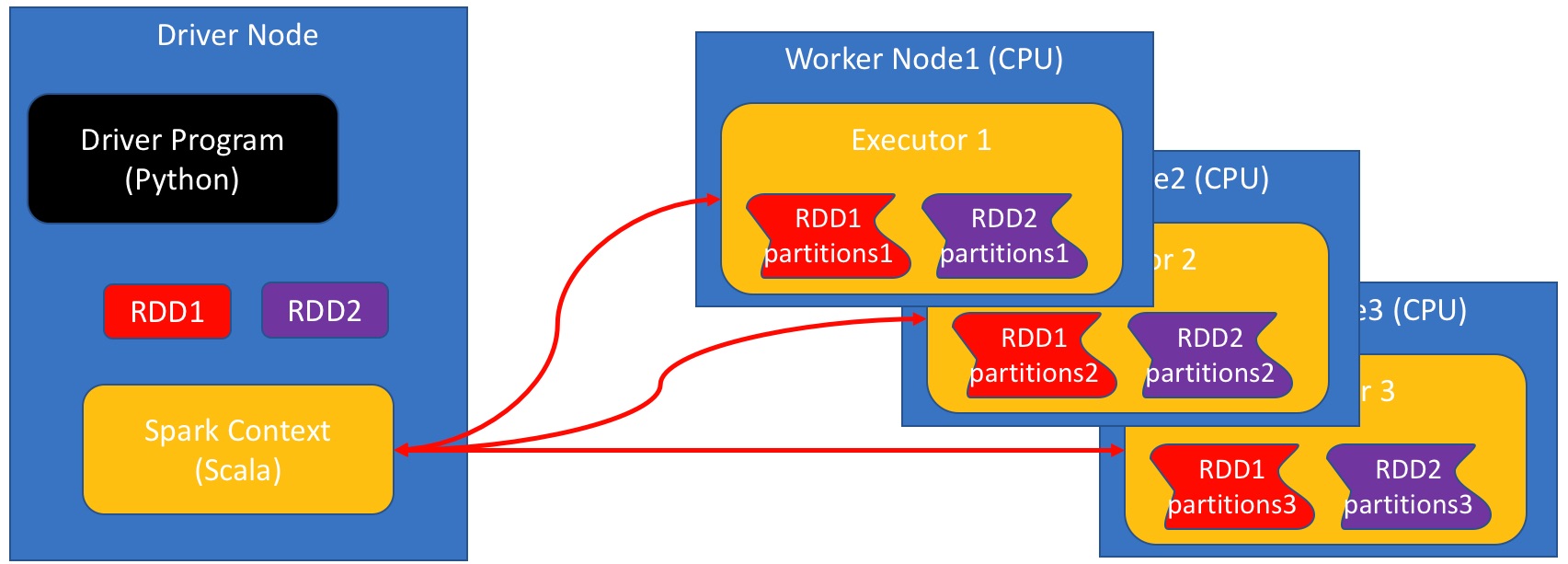Spark Basics 1¶
This notebook introduces two fundamental objects in Spark:
The Spark Context
The Resilient Distributed DataSet or RDD
Spark Context¶
We start by creating a SparkContext object named sc. In this case we create a spark context that uses 4 executors (one per core)
from pyspark import SparkContext
sc = SparkContext(master="local[4]")
sc
<pyspark.context.SparkContext at 0x108284a90>
Only one sparkContext at a time!¶
When you run spark in local mode, you can have only a single context at a time. Therefor, if you want to use spark in a second notebook, you should first stop the one you are using here. This is what the method .stop() is for.
# sc.stop() #commented out so that you don't stop your context by mistake
RDDs¶
RDD (or Resilient Distributed DataSet) is the main novel data structure in Spark. You can think of it as a list whose elements are stored on several computers.

Some basic RDD commands¶
Parallelize¶
- Simplest way to create an RDD.
- The method
A=sc.parallelize(L), creates an RDD namedAfrom listL. Ais an RDD of typeParallelCollectionRDD.
A=sc.parallelize(range(3))
A
ParallelCollectionRDD[0] at parallelize at PythonRDD.scala:423
Collect¶
- RDD content is distributed among all executors.
collect()is the inverse of `parallelize()'- collects the elements of the RDD
- Returns a list
L=A.collect()
print type(L)
print L
<type 'list'> [0, 1, 2]
Using .collect() eliminates the benefits of parallelism¶
It is often tempting to .collect() and RDD, make it into a list, and then process the list using standard python. However, note that this means that you are using only the head node to perform the computation which means that you are not getting any benefit from spark.
Using RDD operations, as described below, will make use of all of the computers at your disposal.
Map¶
- applies a given operation to each element of an RDD
- parameter is the function defining the operation.
- returns a new RDD.
- Operation performed in parallel on all executors.
- Each executor operates on the data local to it.
A.map(lambda x: x*x).collect()
[0, 1, 4]
Reduce¶
- Takes RDD as input, returns a single value.
- Reduce operator takes two elements as input returns one as output.
- Repeatedly applies a reduce operator
- Each executor reduces the data local to it.
- The results from all executors are combined.
The simplest example of a 2-to-1 operation is the sum:
A.reduce(lambda x,y:x+y)
3
Here is an example of a reduce operation that finds the shortest string in an RDD of strings.
words=['this','is','the','best','mac','ever']
wordRDD=sc.parallelize(words)
wordRDD.reduce(lambda w,v: w if len(w)<len(v) else v)
'is'
Properties of reduce operations¶
Reduce operations must not depend on the order
- Order of operands should not matter
- Order of application of reduce operator should not matter
Multiplication and summation are good:
1 + 3 + 5 + 2 5 + 3 + 1 + 2- Division and subtraction are bad:
1 - 3 - 5 - 2 1 - 3 - 5 - 2B=sc.parallelize([1,3,5,2])
B.reduce(lambda x,y: x-y)
-9
Which of these the following orders was executed?
- $$((1-3)-5)-2$$ or
- $$(1-3)-(5-2)$$
Using regular functions instead of lambda functions¶
- lambda function are short and sweet.
- but sometimes it's hard to use just one line.
- We can use full-fledged functions instead.
A.reduce(lambda x,y: x+y)
3
Suppose we want to find the
- last word in a lexicographical order
- among
- the longest words in the list.
We could achieve that as follows
def largerThan(x,y):
if len(x)>len(y): return x
elif len(y)>len(x): return y
else: #lengths are equal, compare lexicographically
if x>y:
return x
else:
return y
wordRDD.reduce(largerThan)
'this'